Archive for the ‘Green Roofing’ Category
Blue Instead of White for Reflective Roofs?
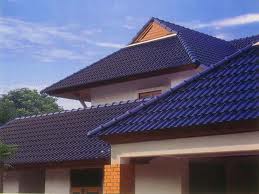
Research from Oregon State University describes how deep blue may be just as effective as white roofs in keeping the buildings cool. The researchers state that the sun’s rays don’t make objects warmer until they have been absorbed into the ground and get radiated as heat. So to keep a roof cool, you want to reflect the sun’s rays before it can be turned into heat.
Changing the chemical makeup of darker pigments can reflect as much of the rays as the common white roofs currently being used. The Oregon researchers mixed up and heated a bright blue pigment with manganese, yttrium and indium oxide that reflects the sun’s rays extremely well.
Cool Roof Color Choices Coming Soon
Other colors can be modified to be used in the cool roof tiles and the cost is nearly the same as asphalt or rubber roofing materials commonly used. The U.S. Recovery and Reinvestment Act funds are being spent for basic research into the new reflective pigments.
Cool roofs can reflect between 29 and 78 percent of the sun’s heat compared to 10 to 20 percent on conventional roofs. Construction of cool roofs is becoming standard procedure for new roofs, the Department of Energy calls for cool roofs to be incorporated whenever practical.
The Lawrence Berkeley National Laboratory’s Heat Island Group says an energy savings of $15 billion over 20 years, the average lifespan of a roof, for retrofitting 14,000 square miles of roofing.
This might be especially useful for apartment buildings that tower over flat white roofs. Tenants often complain about the bright white surface when looking out their windows.
White Roof Rewards
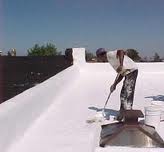 The average home and commercial building in the U.S. is made up of a dark roof material, often containing elements of tar or asphalt. While these types of roofs may not seem inherently flawed, innovations in the roofing industry have begun to shed light on some issues surrounding dark-colored rooftops.
The average home and commercial building in the U.S. is made up of a dark roof material, often containing elements of tar or asphalt. While these types of roofs may not seem inherently flawed, innovations in the roofing industry have begun to shed light on some issues surrounding dark-colored rooftops.
Energy Efficiency
The sun is a vital component to the survival of our planet, but it’s rays can also be very damaging. Even in areas such as rooftops, the damaging rays of the sun can cause big problems for the durability of the materials, and the need for increased energy consumption within the home. In other words, not only are dark-colored roofs higher maintenance, they also are far less energy efficient than a newer technology; white roof systems.
As one of the most recent additions to the green roofing movement, white roof systems can reduce the heat absorption of roof materials. Less heat absorption means reduced need for traditional energy consumption, cutting summer cooling costs by 20 or more percent. Some industry experts have compared the use of a white roof system to that of replacing your traditional light bulbs to CFL bulbs, and are cited as an inexpensive way to reduce the energy consumption of a home.
Although having been around for decades, white roof systems have begun to gain popularity in recent years as the shift from traditional energy to more environmentally friendly products has gained momentum.
Solar Roof Perks
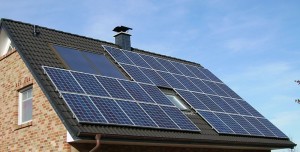 You may have seen a commercial building, or even a progressive residential home, with solar panels and wondered what all the fuss is about. While solar roofs are just now gaining momentum in popularity, the benefits are bound to last a lifetime.
You may have seen a commercial building, or even a progressive residential home, with solar panels and wondered what all the fuss is about. While solar roofs are just now gaining momentum in popularity, the benefits are bound to last a lifetime.
Lasting Effects
The most obvious benefit of having a solar roof is the environmental impact. By absorbing the sun’s rays, these roof systems generate power that can be used to service the home or building. The average home can generate enough power to sustain its electrical usage for 24 hours, thereby reducing the consumption of traditional energy. Reducing the consumption of traditional electricity saves the homeowner money, but also decreases carbon emissions produced by a long-term reduction in the need for manufacturing of electricity.
Solar roofs may be more costly than traditional roof repair costs for materials, but they are also longer lasting. Many of these systems come with warranties well above the average 20 year found for other roof materials. Further, there are government rebate programs and tax deductions available for the installation of a solar roof system.
Green Roofing For Homeowners
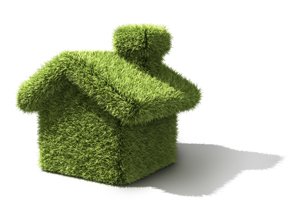 The construction and roofing industries are working hard to take part in the growing use of eco-friendly products, and many homeowners are also becoming more aware of their role. For many, this comes as a huge undertaking, as learning about the different product possibilities can often seem overwhelming. Luckily, there are a few green roof products available to help homeowners make their stamp towards their efforts of helping protect the environment.
The construction and roofing industries are working hard to take part in the growing use of eco-friendly products, and many homeowners are also becoming more aware of their role. For many, this comes as a huge undertaking, as learning about the different product possibilities can often seem overwhelming. Luckily, there are a few green roof products available to help homeowners make their stamp towards their efforts of helping protect the environment.
Green Roofing Products
The term green roof is often associated with the idea of a rooftop garden or vegetative plant-based roof covering. While these are two easy ways to make your roof more environmentally friendly, the look and upkeep isn’t always conducive to all families. Other green roof products include:
Photovoltaic roof systems — also known as solar roof panels, these roof panels absorb energy from the sun; which is then turned into electricity that can be used to power the home. Helping to reduce the need for traditional energy consumption, these roof systems save the homeowner money and help reduce the amount of carbon emissions needed to generate electrical power.
White roof systems — also known as cool roofs, the existing roof materials are coated by a protective white coating. By reflecting the suns heat rays, a white roof system reduces the energy consumption of a home by 30% or more.
Alternative tile roof systems — come in two main eco-friendly forms; metal roofs or tile roofs. Metal roofs are made mostly from recycled metal materials. With the ability reflect 35% of the sun’s heat rays, a metal roof is also more durable and longer lasting in most climates. A tile roof can be made from slate, stone or clay; all earth-bound materials. The eco-friendly materials these are made from are also more resistant to fire, pets and severe weather.
Green Roofing Products Take The Lead
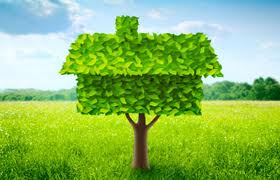 Environmental awareness and protection is a new trend among many industries, including roofing and construction. A recent survey looking into green home building materials named two green roof products among the top five for the year.
Environmental awareness and protection is a new trend among many industries, including roofing and construction. A recent survey looking into green home building materials named two green roof products among the top five for the year.
Topping The Charts
Listed as one of the top five green building materials for the upcoming year, MBCI Eco-ficient roofing panels were chosen for their wide range of benefits. Described as a roofing panel that can “do it all”, these metal roofing panels offer better thermal performance that is designed to improve energy efficiency and reduce the need for added heating or cooling costs inside a home or building. These panels offer quick installation in commercial roofing projects, saving the roof contractor time and money. Further, these panels come with little need for maintenance and even carry a 40 or more year durability warranty.
Insulfoam HD Composite Roof Insulation is also making its mark in the green roof industry by becoming a strong competitor among other foam roof products. This lightweight, closed-cell panel is one of the strongest and least expensive composite roof products available today. Insulfoam HS is compatible with a range of roofing membranes like EPDM (M-class rubber), TPO (thermoplastic polyolefin), PVC (polyvinyl chloride), CSPE (chlorosulfonated polyethylene), built-up and modified bitumen membrane systems. Most importantly, the green roof benefits are displayed in the fact that it is 100% recyclable and contains no formaldehyde or HCFC’s.
Green Roof Plan Falling behind in Portland
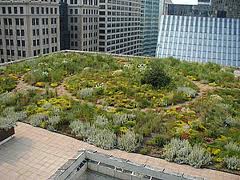
Portland Oregon set a goal of 43 acres of eco-roofs by 2013; so far the city has only 17.7 acres of green roof systems. Portland introduced Grey to Green, a sustainable storm water management practice program. The city pays up to $5 per square foot for new green roof projects within city limits, currently the new roof costs between $5 and $20 per square foot.
As well as the environmental benefits, a green roof can provide a relaxing or recreational aspect to a roof. According to the industry trade group ‘Green Roofs for Healthy Cities’ the green roof market has grown 115% in 2011.
Green Roof Has Many Benefits
Eco roofs, also known as green, living and vegetative roof systems reduce and filter storm water, reduce air pollution, provide a natural habitat for insects and plants, reducing the urban heat island effect and provide added insulation to a building thereby reducing the cooling costs during hot months. A green roof can also increase the life expectancy of the roof, lessen noise levels and provide additional usable space.
One of the reasons people are hesitant to install a living roof is the initial cost. A 2008 Portland study researched a detail cost analysis on traditional roofs versus a green roof. On a 40,000 square foot roof, the green roof would cost $128,803 more after 5 years, but the savings over 40 years was $403,632.
Catholic University Installs Green Roof
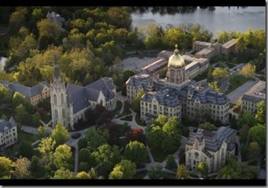
The Catholic University of America in District of Columbia is installing a green roof on top of Aquinas Hall. Approximately 1/3 of the roof will be filled with living plants and the other 2/3 has existing solar panels that supply electricity to the building.
Richard Weil senior project manager said “the new insulation board was completely installed and trimmed at the two roof drains, so remaining work includes the roof membrane, parapet wall coping, railing post sealing and green module installation”.
Green Roof Cooler than Asphalt Roof
There will be 4-6 inches of soil that will supply added insulation for the building. There will be a variety of sustainable grasses and plants to absorb the sun keeping the building cooler.
When the roof is finished, little to no maintenance will be required. The plants and grasses will be able to live on their own. Brian Alexander, director of energy and utilities management said “Moving parts break, with a green roof all you have to do is sit back and it makes power.”
The new roof is part of the University’s promise to become more environmentally friendly and energy efficient. Besides having 2,600 solar panels making the university the biggest solar installation in District of Columbia, they also have a lawn over the law school parking garage and a garden on top of Father O’Connell Hall.
Many of the buildings and carports have solar panels to supply their energy. The students designed a solar powered picnic table that produces enough energy to power electronic devices.
Hospital Living Roof Speeds Healing
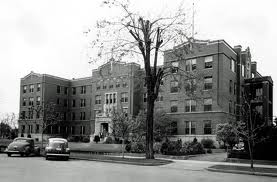
Providence St. Mary Medical Center in Walla Walla Washington is losing the gravel roof and installing a vegetative roof. Director of Public Affairs Kathleen Obenland says “there’s been studies that have actually shown that patients who have a more pleasing view, need less pain medication, they feel better, heal faster”.
The cost of the roof project is about $600,000. Installation of the green roof is due to be completed next week. They are using a roll out product with green sedums from the nursery. In the near future they plan on adding murals on the exposed walls hiding more rooftop units.
Hospital recognized for Environmental Efforts
Obenland went on to say “we believe that as a member of the community, it’s important to be environmentally friendly, and its part of our mission and values.”
Although the green roof has health benefits, for the patients and for the building, the new roof will be closed off to the public.
Other benefits of the green roof will be to reduce storm water runoff, conserve energy, more insulation for the roof and reduce the amount of money spent on power.
The Providence St. Mary Medical Center was founded by Mother Joseph of the Sisters of Providence who arrived in Walla Walla with her sister in 1863. The hospital opened in January 1880 as the first non-military hospital in Washington east of the Cascade Mountains.
Largest Transparent Solar Roof in Country

Pharmaceutical company Novartis, in East Hanover New Jersey is installing the largest transparent solar roof in the country. The transparent solar cells will cover the corporate headquarters roof. The cells will allow natural sunlight to come in and at the same time be delivering Novartis with clean and free energy.
New York architecture firm Rafael Vinoly designed the building and German Company Sunways will be making the integrated photovoltaic transparent cells that will cover the roof.
Unique Solar Designs
Sunways cuts small square holes in solar cells with a special laser and then integrates them into traditional building materials. Incorporating solar into glass panels or tiles allows roofing contractors to be creative with solar installations. The solar cells can be put in places not ordinarily utilized by traditional solar installations.
Sunways will be providing 161,000 5 x 5 inch semi-transparent solar cells for a roof area approximately 2,547 square meters. The building will have a glazed roof and a curtain wall that will be suspended from built up box beams at her roof level.
Other Novartis buildings have interesting roofs. Novartis Vaccines and Diagnostics Research lab in Cambridge MA has a green roof system on a deck overlooking the facilities campus park.
The Novartis campus in Basel Switzerland has a wing shaped roof that appears to be floating over the reception area. The 400 square meter roof is made from glass fiber reinforced plastic, thermal insulation and waterproofing in a single seamless component.
Global Green Roof Efforts
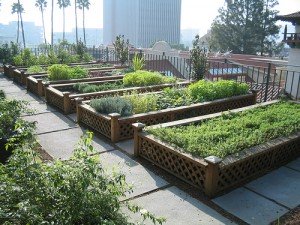 The population growth has once again began to accelerate and, with it, comes additional challenges for the environment. More people means more crowding and, as a result, more demand for clean air. With the population of urban areas expected to double by 2030, the UN has proposed an approach to build healthier cities.
The population growth has once again began to accelerate and, with it, comes additional challenges for the environment. More people means more crowding and, as a result, more demand for clean air. With the population of urban areas expected to double by 2030, the UN has proposed an approach to build healthier cities.
Planning For The Future
The need for cleaner urban environments to sustain living organisms is going to come to a head very soon. Known for toxic smog and lack of green space, urban areas are one of the unhealthiest environments on earth. With the expected leap in population growth predicted to occur over the next 15 to 20 years, measures are being taken to reduce pollution and improve air quality among some of the largest cities, worldwide.
One of the simplest solutions is the addition of more parks, sustaining more trees and plant life. New roof gardens are also in the words, which would boast gardens, plants and grasses along the rooftops. Green roof solutions are well known for their ability to filter pollution and soak up heat-trapping carbon dioxide, releasing clean oxygen back into the environment. Further, installing green roof systems along rooftops in urban areas can help create a cooling effect, reducing the need use of heating and cooling systems inside buildings.
The improvement in urban areas boasting green roof systems has been proven over time, as they have been a part of rural living for hundreds of years. If even a fraction of the earth’s major cities installed a handful of these systems, the effects for the living organisms that inhabit these areas can be monumental.






